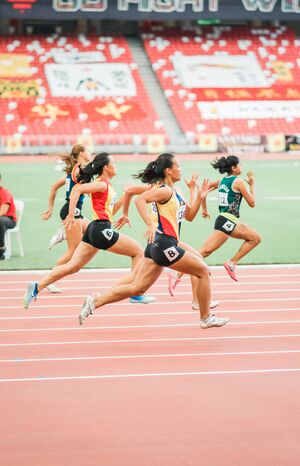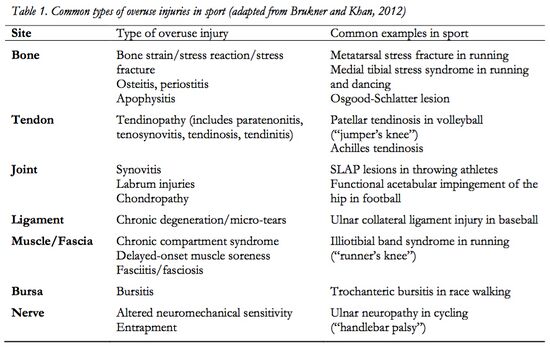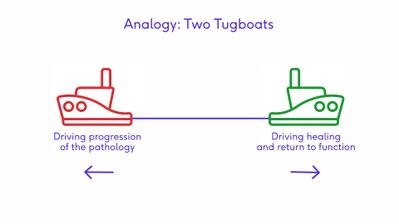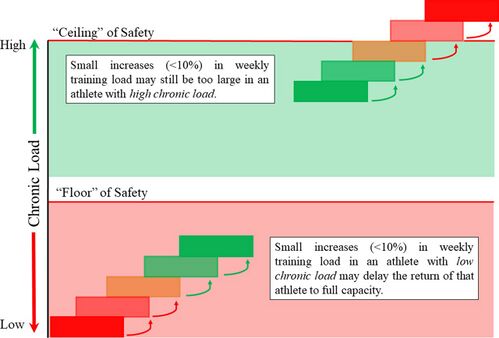Overuse Injuries - an Individualised Approach
Original Editor - Wanda van Niekerk based on the course by Merike Hopkins
Top Contributors - Wanda van Niekerk, Lucinda hampton, Kim Jackson, Tarina van der Stockt and Jess Bell
Introduction[edit | edit source]
Overuse injuries are a common phenomenon and challenging to assess and manage. Various factors contribute to the development of these type of injuries. The diagnosis, treatment and understanding why the injury occurred are some of the challenges that clinicians may deal with in the management of athletes with overuse injuries.
Definition of Overuse Injuries[edit | edit source]
Overuse injuries are characterised by the absence of a single, identifiable or traumatic cause. There is a gradual onset and injury is caused by repeated micro-trauma.[1] The term "overuse" is used as the onset of these type of injuries are usually precipitated by a period of inappropriate tissue loading such as:[2]
- Excessive magnitude or volume of load
- Insufficient recovery between bouts of load
Why Does Overuse Lead to Injury?[edit | edit source]
An overuse injury is usually caused by repetitive activities over a period of time. This repetitive microtrauma overloads the capacity of the tissue to repair itself.[2] During exercise, the various tissues such as muscles, tendons, bones and ligaments, are being loaded and experience excessive physiological stress. After the specific exercise activity, the tissues undergo adaptation in order to strengthen and to be able to withstand similar stress in the future. If the adaptive capability of a specific tissue type is exceeded and injury occurs, this is most often an overuse injury. Therefore, in overzealous athletes, that do not allow adequate time for adaptation to occur before the next workout or training session, the cumulative tissue damage eventually exceeds the threshold that the tissue can handle and this causes pain and dysfunction.[2]
Structures Affected by Overuse Injuries[edit | edit source]
- Bone
- eg. bone stress injuries, stress fracture, osteitis, periostitis, apophysitis
- Tendons
- eg. tendinopathy
- Ligaments
- eg. medial ulnar collateral ligament injury in baseball pitchers
- Muscle
- eg. myofascial pain, chronic compartment syndromes, exercise-induced muscle soreness
- Bursa
- subacromial bursa, greater trochanteric bursa
- Nerve
- eg. nerve entrapment syndromes
- Cartilage
- Skin
- eg. blisters
Risk Factors of Overuse Injuries[edit | edit source]
Training loads, intense competition schedules and inadequate or insufficient recovery are some of the factors that place athletes at higher risk for developing an overuse injury. Risk factors can also be classified as intrinsic and extrinsic risk factors:[3][4]
- Intrinsic Risk Factors
- Malalignment issues, eg genu valgum or varum, patella alta, femoral neck anteversion
- Leg length discrepancy
- Muscle imbalance
- Muscle weakness
- Flexibility issues, such as generalised muscle tightness, restricted joint range of motion
- Body composition
- Extrinsic Risk Factors
- Training load errors, such as excessive volume, intensity, increase, inadequate recovery
- Surfaces
- Shoes
- Equipment
- Environmental conditions
- Nutrition
- Psychological factors
Physiotherapy and Overuse Injuries[edit | edit source]
Physiotherapists are advocates for physical activity and are closely involved and invested in restoring the appropriate level of function in clients. This level of function is different for every client or athlete, and it is crucial that a customised and individualised approach is used. Ways to help athletes back to their highest level of function and return to play is by having good knowledge about the athlete’s specific sport and understanding the physical and psychological requirements and demands of the sport.[5]
Patient education is important in the management of overuse injuries. Furthermore, it is of great value to involve the multidisciplinary team and coaches. The treatment or intervention approach is based on managing the load and/or the forces that caused the injury so that the involved tissue has enough healing time, but also to build resilience against these forces.[6] A helpful imagery to use in educating patients about their overuse injury is the image of two tugboats pulling against each other. The green tugboat (good) will drive the overuse injury into healing and return to function or sport, whereas the red tugboat will draw the overuse injury away from healing and into more serious pathology. The key is to find the balance and fuelling the green tugboat with all the necessary interventions to facilitate healing, but not in a way that fuels the red tugboat and aggravates the pathology.[5] In developing a treatment plan it is key to educate the client and to have a multidisciplinary and holistic approach. A dynamic flexible timeline should be established and a multi-phased, evidence-based and functional progression should be part of the intervention plan.
Assessment of Overuse Injuries[edit | edit source]
Key factors to consider in the assessment of an overuse injury include:[7]
- the structure involved
- the nature and severity of the injury
- the duration of injury from the onset of symptoms – this will aid in understanding the progression of pathology
Diagnosis of Overuse Injury[edit | edit source]
Clinical history[edit | edit source]
- This is an important and valuable tool in the diagnosis of an overuse injury
- Listen to what your client, the coach or other medical staff working with the athlete is telling you!
- Establish specific causative factors (intrinsic and extrinsic)
- Also consider the forces created on the structures when the athlete is not taking part in sport (such as housework, gardening) - it is key to understand the total amount of forces created on the structure involved
- Consider certain populations more at risk of overuse injuries such as:
- Children – the changing nature of training and competition in youth sports, combined with an immature musculoskeletal system[8]
- Female athletes (Female Athlete Triad)[9]
- Older athletes – factors such as bone density loss or old degenerative issues that may predispose to overuse injuries
Diagnostic Imaging[edit | edit source]
- Plain Radiographs – to diagnose associated or incidental bony abnormalities
- Ultrasound – effective imaging method for tendinopathies, although it is operator dependent
- MRI
- CT
Diagnosis[edit | edit source]
Identify the structure(s) involved, the nature and severity, as well as the duration from the onset. This will provide insight into the progression of the pathology. Early diagnosis significantly reduces the barriers to an optimal healing process.
Management of Overuse Injuries[edit | edit source]
A phase-appropriate intervention is necessary for the management of overuse injuries. Athletes present at different points of progression in the pathology (i.e. some will present early on with an overuse reaction, whereas others might have been struggling with an injury for much longer and the pathology of the injury is far more progressed.) Treatment aims can include:[4]
- Identify and address the cause of injury
- Reduce inflammation and pain
- Promote healing
- Prevent complications
- Restore normal use of the injured area
- Develop a return to play strategy, as dictated by symptoms
Optimise tissue healing by systematically, gradually and optimally loading the structures in order to provide restoration of function and capacity.
Treatment modalities may include:
- Relative or graded rest and avoidance of aggravating activities while maintaining fitness[10]
- Recovery protocols
- Manual therapy
- Strengthening and rehabilitation[10]
- Phase appropriate loading
- Exercises for progressive loading and conditioning (and also limiting the effects of detraining)
- Referral to appropriate healthcare providers
- Psychologists - psychological readiness for return to play
- Dietitians - appropriate nutritional advice considering the energy demand of the sport
- Sports physician or specialists
References[edit | edit source]
- ↑ Chéron C, Le Scanff C, Leboeuf-Yde C. Association between sports type and overuse injuries of extremities in adults: a systematic review. Chiropractic & manual therapies. 2017 Dec;25(1):1-0.
- ↑ 2.0 2.1 2.2 Clarsen B. Overuse injuries in sport: development, validation and application of a new surveillance method.(dissertation). Oslo Sports Trauma Research Centre. Norwegian School of Sports Sciences. 2015
- ↑ DiFiori JP, Benjamin HJ, Brenner JS, Gregory A, Jayanthi N, Landry GL, Luke A. Overuse injuries and burnout in youth sports: a position statement from the American Medical Society for Sports Medicine. British journal of sports medicine. 2014 Feb 1;48(4):287-8.
- ↑ 4.0 4.1 Brukner P. Clinical Sports Medicine: Injuries. McGraw-Hill Education (Australia) Pty Limited; 2017.
- ↑ 5.0 5.1 Merike Hopkins. An Individualised Approach to Overuse Injuries. Physioplus, Course. 2021
- ↑ Silbernagel KG, Hanlon S, Sprague A. Current clinical concepts: conservative management of Achilles tendinopathy. Journal of athletic training. 2020 May;55(5):438-47.
- ↑ Aicale R, Tarantino D, Maffulli N. Overuse injuries in sport: a comprehensive overview. Journal of orthopaedic surgery and research. 2018 Dec;13(1):1-1.
- ↑ Wu M, Fallon R, Heyworth BE. Overuse injuries in the pediatric population. Sports medicine and arthroscopy review. 2016 Dec 1;24(4):150-8.
- ↑ Thein-Nissenbaum J, Hammer E. Treatment strategies for the female athlete triad in the adolescent athlete: current perspectives. Open access journal of sports medicine. 2017;8:85.
- ↑ 10.0 10.1 Cardoso TB, Pizzari T, Kinsella R, Hope D, Cook JL. Current trends in tendinopathy management. Best Practice & Research Clinical Rheumatology. 2019 Feb 1;33(1):122-40.










